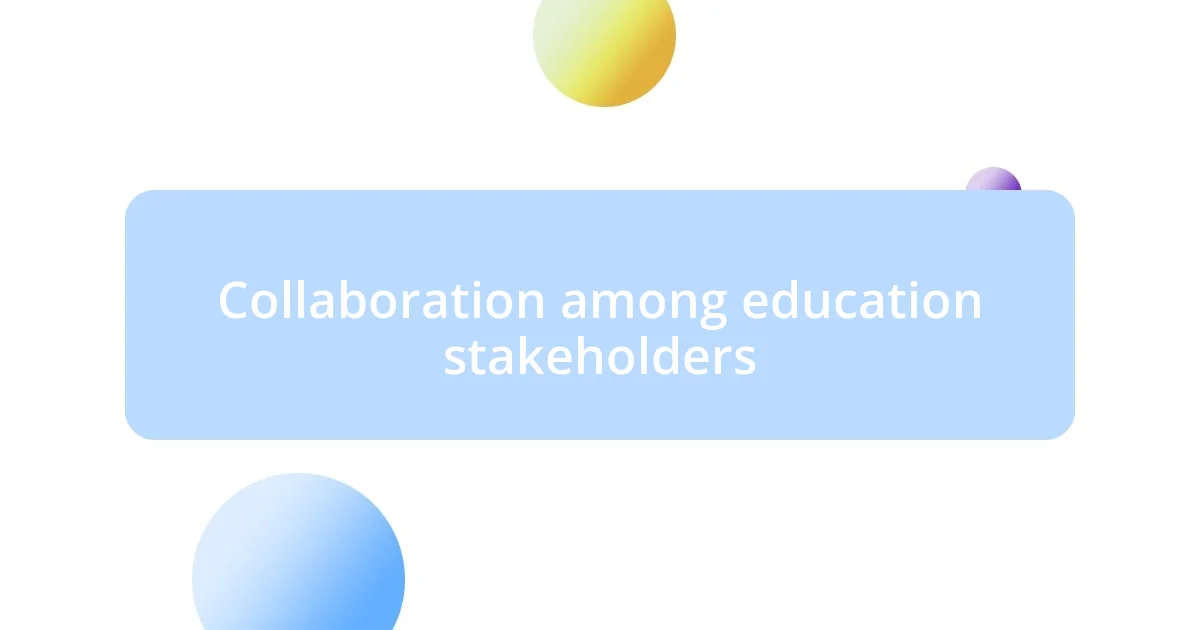Key takeaways:
- Inclusive education promotes a supportive environment where all students learn together, fostering diverse perspectives and enhancing social skills.
- Key strategies for implementation include differentiated instruction, collaboration among educators and families, and creating an accommodating classroom environment.
- Measuring success in inclusion should involve tracking emotional well-being and peer relationships, alongside academic performance, to reflect holistic student growth.

Understanding inclusive education practices
Inclusive education practices are about creating an environment where every student, regardless of their background or ability, has the opportunity to learn together. I’ve experienced firsthand how powerful it can be to have diverse voices in a classroom, enriching discussions and broadening perspectives. Isn’t it fascinating how different experiences can shape our understanding and spirit of collaboration?
When I think back to my days in education, I remember a classmate with a hearing impairment. Our teacher implemented specific accommodations, like using visual aids and sign language. These small adjustments not only helped my classmate thrive but also taught the rest of us valuable lessons about empathy and inclusion. What if every classroom adopted such practices? Wouldn’t that change the landscape of education for the better?
At its core, understanding inclusive education means recognizing that every student deserves access to quality learning experiences. It’s about moving beyond mere tolerance to genuine acceptance and celebration of differences. I’ve often found myself reflecting on how far we’ve come and how much further we need to go. Can we truly say we’re inclusive if we still have barriers in place?

Benefits of inclusive education
Inclusive education offers numerous benefits that extend beyond the classroom. Personally, I’ve seen how it fosters a sense of belonging among students. When everyone feels welcomed, it encourages meaningful interactions that enhance social skills and emotional intelligence. I remember a moment during group projects when a shy student finally found their voice, contributing ideas that surprised us all. This kind of environment nurtures collaboration and builds friendships that might not have formed otherwise.
Consider these key benefits of inclusive education:
- Diverse Perspectives: Engages students in broader discussions that enrich learning experiences.
- Empathy Development: Builds understanding and compassion among peers, setting a foundation for lifelong social skills.
- Improved Academic Outcomes: Research shows that inclusive classrooms often yield better performance for all students.
- Enhanced Problem-Solving Skills: Students learn to navigate diverse ideas and work effectively in teams.
- Reduced Stigma: Normalizes differences, helping all students embrace diverse abilities and backgrounds.
Reflecting on this, it’s clear that inclusive education does more than accommodate; it transforms the educational landscape for the better.

Key strategies for implementation
In my experience, one of the best strategies for implementing inclusive education is differentiated instruction. This approach tailors learning experiences to meet the diverse needs of students. For instance, I recall a teacher who offered choices in assignments based on students’ learning styles. Some of us thrived with visual projects, while others preferred writing essays. This flexibility allowed everyone to connect with the material in a way that resonated with them, fostering a more engaging learning environment.
Another key element is collaboration among educators, support staff, and families. When I volunteered in an inclusive classroom, I witnessed the magic that happened when teachers and specialists worked together. Regular meetings to discuss student progress, share insights, and align approaches not only created a united front for students but also boosted morale among staff. It’s about building a community focused on the success of every learner.
Lastly, creating an accommodating classroom environment is essential. I remember stepping into a classroom designed with various learning zones tailored for sensory needs. Flexible seating options, quiet corners, and interactive zones invited students to engage in ways that suited them best. This thoughtful setup can help minimize distractions and support focused learning. How can we do less than provide a space where every student feels like they truly belong?
| Strategy | Description |
|---|---|
| Differentiated Instruction | Tailoring tasks to match diverse learning styles and preferences. |
| Collaboration | Working together with educators and families to enhance support for each student. |
| Inclusive Environment | Designing classrooms with varied spaces to foster engagement and comfort. |

Collaboration among education stakeholders
Collaboration among education stakeholders is the backbone of successful inclusive education. I’ve experienced firsthand how powerful it is when teachers, parents, and specialists come together to support a child’s learning journey. For instance, during my time working in a school, we held regular strategy sessions with parents and aides, and the insights shared often illuminated paths we hadn’t considered before. It made me wonder—how could we achieve even greater outcomes if collaboration became a norm rather than an exception?
When stakeholders align their efforts, it creates a supportive network that enriches the educational experience. I remember attending a meeting where a special education teacher shared unique techniques that had transformed her approach to teaching. The general education teachers were inspired and immediately started incorporating those strategies into their classrooms. This kind of open dialogue not only fosters innovation but also builds a sense of community—everyone feels invested in each student’s success.
Ultimately, the synergy among education stakeholders can lead to more personalized support for learners. I think back to a student whose needs were addressed through a comprehensive plan developed by the entire staff. The transformation was remarkable—her grades improved, and she blossomed socially. It made me reflect on just how much more we could achieve if we all worked together. Isn’t the goal of education not just to instruct but to lift each other towards collective success?

Adjustments for diverse learning needs
Adjustments for diverse learning needs are crucial in creating an inclusive learning environment. I recall a time when a teacher implemented flexible deadlines for a student struggling with anxiety. By allowing that child to pace themselves, it removed a significant barrier to their learning and transformed their engagement in the classroom. Isn’t it fascinating how little adjustments can wield such significant impacts?
In my experience, offering various assessment methods also supports diverse learning needs beautifully. I once observed a class where students could choose between a presentation, a creative project, or a traditional test to demonstrate their understanding of a topic. This not only celebrated their strengths but energized the overall atmosphere, encouraging everyone to showcase their unique talents. How often do we overlook the potential for creativity in assessments, when it can enhance learning for so many?
Another adjustment that stands out to me is the use of technology to support personalized learning. I remember seeing a student with reading difficulties flourish when provided with text-to-speech software. It allowed them to access the same materials as their peers while feeling confident in their abilities. It’s a reminder that harnessing technology can bridge gaps and make learning accessible. Isn’t our ultimate goal to empower every student with the tools they need to succeed?

Measuring success in inclusion
Measuring success in inclusion goes beyond academic achievements; it encompasses the emotional and social growth of students as well. I vividly remember a school year when we started collecting feedback from students about their feelings of belonging in the classroom. The difference was stunning; students who once felt isolated began to share their positive experiences, and it really highlighted how crucial their emotional well-being is to their overall success. Isn’t it refreshing when we see inclusion making a tangible impact on students’ lives?
On a different note, I’ve found that tracking improvements in peer relationships also serves as a vital indicator of success in inclusive practices. In one instance, I witnessed friendships blossom between typically developing students and those with special needs during a group project. The camaraderie they developed not only enriched their social skills but also fostered a sense of community in the classroom. It made me think—when we focus on building connections, aren’t we enhancing the educational landscape for everyone involved?
Finally, I believe that the implementation of individualized goals can be a powerful measure of success in inclusion. I worked with a student who had specific communication goals. By celebrating each small milestone with the entire class, I noticed an infectious enthusiasm that encouraged everyone to cheer on their peers. This kind of shared success reinforces the idea that when we invest in each individual’s journey, we collectively benefit. Isn’t that what makes inclusion truly remarkable?

Challenges and solutions in practice
Inclusive education certainly comes with its fair share of challenges. One that stands out for me is the lack of training for educators in handling diverse needs. I remember a workshop I attended where teachers expressed their frustration over feeling unequipped to support students with different learning requirements. It struck a chord with me—imagine being passionate about teaching yet feeling held back because you don’t have the right tools! Providing ongoing professional development can be a solution; equipping teachers not only empowers them but also enhances the learning experience for everyone.
Another challenge I often see is the hesitance of schools to embrace change. While creating an inclusive environment is commendable, many institutions face systemic barriers that can resist such transformations. For instance, I once worked with a school that was resistant to adopting flexible groupings. The staff believed that rigid classroom structures simply worked better. However, after a trial period where students collaborated in mixed-ability groups, the attitude shifted dramatically. Teachers began to see the deep connections among students, proving that flexibility can foster collaboration and empowerment. Have you ever witnessed a shift in perception that made all the difference?
In addressing these challenges, fostering a strong support network can act as a beacon of hope. I remember collaborating with local specialists to deliver workshops aimed at sharing successful inclusive practices. These sessions not only equipped us with new strategies but also built friendships and camaraderie among staff. When educators work together, sharing ideas and solutions, it creates a community that champions inclusion. Isn’t it inspiring to think about the collective power of educators coming together for a common goal?














